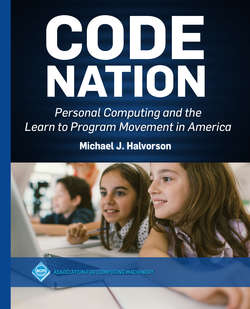Читать книгу Code Nation - Michael J. Halvorson - Страница 14
На сайте Литреса книга снята с продажи.
1.5Programmingpersonal connectionsPersonal connectionsPersonal Connections
ОглавлениеI have wanted to write this book for a long time because I am fascinated with software development. PCs were an important starting place for me during my teenage years, and I first learned to write computer code on early microcomputers and PCs. Like many people of my age and social context, my first experiments with home electronics took place in the family rec room during the late 1970s. My extended family bought a Tandy TRS-80 microcomputer Tandy TRS-80 and an Atari video computer system Atari video computer system, and the young people in our circles used them to play video games like Pong and Missile Command Pong and Missile Command. A bit later, I experimented with an early IBM Personal Computer when it was released in August 1981, just weeks before I entered college at Pacific Lutheran University (PLU) PLU.Pacific Lutheran University (PLU) Pacific Lutheran University (PLU) in Tacoma, Washington. I took an introductory computer programming course and declared as a Computer Science major at PLU, deferring my interests in history and education for graduate school. I learned BASIC, Pascal Pascal, C, and Assembly language assembly language programming on the university’s Digital Equipment Corporation (DEC) DEC.Digital Equipment Corporation (DEC) Digital Equipment Corporation (DEC) VAX 11–780 minicomputers VAX 11-780 and DEC PDP-11 minicomputers DEC PDP-11 PDP-11 minicomputers. I also studied mathematics, data structures, Algorithms algorithms, operating systems, digital logic, computer architecture, computer graphics, and networking theory. In 1985, I graduated from university and I was hired at Microsoft Corporation Microsoft Corporation to work in one of their two Bellevue (Washington) office buildings, just before the company moved to its better-known Redmond campus. I was employee #850 in the rapidly expanding organization (see Figure 1.5), arriving when the best-selling products were MS-DOS, Microsoft Word Microsoft Word for MS-DOS, and a few popular programming languages and development tools.
Figure 1.5Michael Halvorson working in his office at Microsoft Corporation (1990). (Photo courtesy of Michael Halvorson)
During my job interview at Microsoft, I was shown a testing (beta) version of Microsoft Windowsversion 1.0 Microsoft Windows 1.0. It was not very impressive at the time, but the new graphical operating environment for IBM PCs and compatibles would eventually become an exciting platform for many users, programmers, and commercial software publishers. My first work was at Microsoft Press, the book publishing division of Microsoft, founded by Gates, Bill Bill Gates in 1983 to provide technical support for computer enthusiasts who were frustrated by the poor quality of software manuals. In the early days of personal computing, product documentation was often little more than printouts assembled in a three-ring binder, and there was not much in the way of computer-based help or training for PC users. From these humble beginnings, a major publishing industry took shape. It came to include bestselling magazines like PC Magazine, Macworld, and Compute!, as well as the computer book publishers Howard W. Sams, O’Reilly, Osborne McGraw-Hill, Que, Microsoft Press Microsoft Press, Sybex, and IDG Books.
Our work at Microsoft Press was to help self-taught programmers and those who used Microsoft’s business applications to get the most out of their software. I edited books, worked with independent authors, attended industry trade shows, and (beginning in 1986) started writing Do-it-yourself (DIY) do-it-yourself (DIY) computer books about using operating systems and programming languages. I was lucky that my university training required a healthy dose of the liberal arts along with my computing classes. Both fields of study prepared me to tackle substantial research and writing projects in the years to come, and they were valued in the book publishing division.
The Learn-to-program movement learn-to-program movement was something that I saw first-hand while working with Microsoft’s customers and authors. In particular, there were fascinating people to learn from at computer industry trade shows, especially COMDEX COMDEX and Macworld Expo Macworld Expo. (See Figure 1.6.) In 1989, I co-authored the book Learn BASIC Now with my colleague and friend, Rygmyr, David David Rygmyr, and the book was carefully edited by Sheppard, Megan Megan Sheppard and Magee Jr., Dail Dale Magee, Jr. (also employees of Microsoft Press). Our programming courseware included a full-featured version of the Microsoft QuickBASIC Interpreter for MS-DOS on three 5.25” disks, and Bill Gates wrote a Foreword to the book recalling his personal connection to Altair BASIC BASICAltair BASIC Altair BASIC and his interest in using BASIC as a unifying language across computing platforms. (See Chapter 5.)
Learn BASIC Now sold many copies and it was selected as a finalist for a national book award in the computer book “How To” category. Our self-study guide clearly intersected with the powerful demand for programming instruction, and the low-cost QuickBASIC Interpreter made the product relatively inexpensive for newcomers. Over the years, I wrote another 15 books about software development, mostly for self-taught programmers and those who wanted to learn the newest features of popular products like Microsoft Visual Basic Microsoft Visual Basic or Microsoft Visual Studio Microsoft Visual Studio. Through the books, I was actively connected to publishers, software development teams, user groups, academics, journalists, literary agents, and a wide range of computer users—many of whom would write or email us directly for help.
